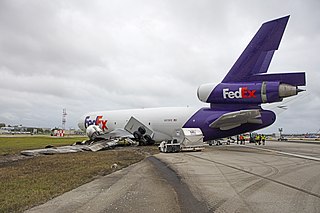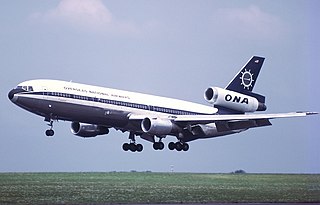
The Boeing 777, commonly referred to as the Triple Seven, is an American long-range wide-body airliner developed and manufactured by Boeing Commercial Airplanes. The 777 is the world's largest twinjet and the most-built wide-body airliner. The jetliner was designed to bridge the gap between Boeing's other wide body airplanes, the twin-engined 767 and quad-engined 747, and to replace aging DC-10 and L-1011 trijets. Developed in consultation with eight major airlines, the 777 program was launched in October 1990, with an order from United Airlines. The prototype aircraft rolled out in April 1994, and first flew in June of that year. The 777 entered service with the launch operator United Airlines in June 1995. Longer-range variants were launched in 2000, and first delivered in 2004.

Saudia, formerly known as Saudi Arabian Airlines, is the flag carrier of Saudi Arabia, based in Jeddah. The airline's main hubs are the King Abdulaziz International Airport in Jeddah and the King Khalid International Airport in Riyadh, the latter of which it plans to move out of by 2030.
Atlas Air, Inc. is a major American cargo airline, passenger charter airline, and aircraft lessor based in White Plains, New York. It is a wholly owned subsidiary of Atlas Air Worldwide Holdings. Atlas Air is the world's largest operator of the Boeing 747, with 54 of the type. In 2021, the airline had 4,056 employees and operated to more than 300 global destinations.
Compañía Dominicana de Aviación, usually shortened to Dominicana, was an airline based in the Dominican Republic and served as the flag carrier for the country.

Kalitta Air is an American cargo airline headquartered at Willow Run Airport, Ypsilanti Township, Michigan. The company operates international scheduled and cargo charter services. Its call sign "Connie" is from its founder, Connie Kalitta.

The Convair 990 Coronado is a retired American narrow-body four-engined jet airliner produced between 1961 and 1963 by the Convair division of American company General Dynamics. It was a stretched version of its earlier Convair 880 produced in response to a request from American Airlines: the 990 was lengthened by 10 ft (3.0 m), which increased the number of passengers from between 88 and 110 in the 880 to between 96 and 121. This was still fewer passengers than the contemporary Boeing 707 or Douglas DC-8, although the 990 was 25–35 mph (40–56 km/h) faster than either in cruise.

The McDonnell Douglas MD-11 is an American tri-jet wide-body airliner manufactured by American manufacturer McDonnell Douglas (MDC) and later by Boeing. Following DC-10 development studies, the MD-11 program was launched on December 30, 1986. Assembly of the first prototype began on March 9, 1988. Its maiden flight occurred on January 10, 1990, and it achieved Federal Aviation Administration (FAA) certification on November 8. The first delivery was to Finnair on December 7 and it entered service on December 20, 1990.

Delta Air Lines Flight 1141 was a scheduled domestic passenger flight between Dallas Fort Worth International Airport, Texas, and Salt Lake City International Airport, Utah. On August 31, 1988, the flight, using a Boeing 727-200 series aircraft, crashed during takeoff at Dallas Fort Worth International Airport, resulting in 14 deaths and 76 injuries among the 108 on board.
ABX Air, Inc., formerly Airborne Express, is a cargo airline headquartered at Wilmington Air Park near the City of Wilmington, Ohio, US. ABX Air operates scheduled, ad hoc charter and ACMI freight services. It also provides flight support services and training. ABX Air is owned by Air Transport Services Group.

Birgenair was a Turkish charter airline established in 1988 with headquarters in Istanbul, Turkey. It ceased operations in October 1996, following the crash of Birgenair Flight 301.

As of December 2024, a total of 64 Boeing 747 aircraft, or just above 4% of the total number of 747s built, first flown commercially in 1970, have been involved in accidents and incidents resulting in a hull loss, meaning that the aircraft was either destroyed or damaged beyond economical repair. Of the 64 Boeing 747 aircraft losses, 32 resulted in no loss of life; in one, a hostage was murdered; and in one, a terrorist died.

British Airways Flight 38 was a scheduled international passenger flight from Beijing Capital International Airport in Beijing, China, to London Heathrow Airport in London, United Kingdom, an 8,100-kilometre trip. On 17 January 2008, the Boeing 777-200ER aircraft operating the flight crashed just short of the runway while landing at Heathrow. No fatalities occurred; of the 152 people on board, 47 sustained injuries, one serious. It was the first time in the aircraft type's history that a Boeing 777 was declared a hull loss, and subsequently written off.
Eastern Airlines, LLC is an American airline founded in 2010. It began as Dynamic Airways and later added "International" to its name to reflect its transition from a charter airline into scheduled international services. Under the Dynamic name, the airline was headquartered in High Point, North Carolina, offering service from New York to South America. It used to operate from Fort Lauderdale, Chicago, Los Angeles, and New York to the Caribbean, Cancún, and South America.

British Airways Flight 2276 was a scheduled international passenger service from Las Vegas to London. On 8 September 2015, the Boeing 777-200ER operating the flight suffered an uncontained engine failure and fire in the left (#1) GE90 engine during take-off from Las Vegas-McCarran International Airport, prompting an aborted take-off and the evacuation of all passengers and crew. All 170 people on board survived, but 20 were injured.

American Airlines Flight 383 was a scheduled domestic passenger flight from O'Hare International Airport in Chicago, Illinois to Miami International Airport. On October 28, 2016, the Boeing 767-300ER operating the flight suffered an engine fire during takeoff. The crew aborted their takeoff, evacuating everyone on board, of whom 21 were injured. The plane was a write-off.

On October 28, 2016, FedEx Express Flight 910, a McDonnell Douglas MD-10-10F flying from Memphis International Airport to Fort Lauderdale–Hollywood International Airport was involved in a runway skid after a landing gear collapse, which resulted in a fire completely destroying the left engine and wing. Two crew members, the only people on board, were unharmed.

Overseas National Airways (ONA) Flight 032 was a non-scheduled positioning flight operated by Overseas National Airways with a McDonnell Douglas DC-10-30CF. On November 12, 1975, the flight crew initiated a rejected takeoff after accelerating through a large flock of gulls at John F. Kennedy International Airport, resulting in a runway excursion. Of the 139 aircraft occupants, all survived, while the aircraft was destroyed by an intense post-crash fire. The National Transportation Safety Board concluded that the probable cause of the accident was bird ingestion into the right-hand engine, causing an uncontained engine failure that ruptured several landing gear tires and disabled the engine's hydraulic system, in turn partially disabling the spoilers and the landing gear brakes. Contributing to the accident was the resultant failure of the affected engine's thrust reverser and the wet runway. The accident aircraft is claimed to be the largest commercial airliner ever destroyed due to a bird strike.

American Airlines Flight 102 was a regularly scheduled flight operated by a McDonnell Douglas DC-10 from Honolulu International Airport to Dallas/Fort Worth International Airport. On 14 April 1993, upon landing, it was raining at Dallas-Ft Worth International Airport, and there were numerous thunderstorms in the area. Shortly after touchdown on runway 17L, the pilot lost directional control as the aircraft began to weathervane, and it departed the right side of the runway. All 202 occupants on board survived, with two passengers suffering serious injuries during the emergency evacuation. The aircraft was badly damaged and was written off.














